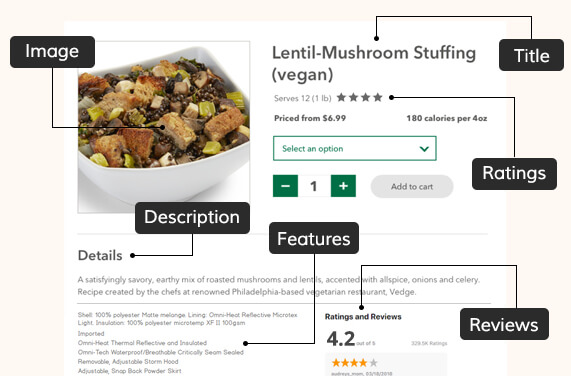
Now more than ever, people are choosing online stores to shop instead of the brick-and-mortar ones. And, with over 300 million active customers(and counting,) there’s no denying that Amazon is at the centre of this growing eCommerce frenzy.
Do you think a basic Amazon product listing is enough to tap into that marketplace of potential?
It’s no secret that a compelling product listing can do wonders for online sellers. It’s a crucial part of Amazon SEO that can directly affect your eStore’s visits, conversions, & profits. And, it can give you an edge over the competition.
While certain limitations govern an Amazon product listing, it’s up to you to make it engaging enough to attract the right crowd. How do you do that? Well, one way is to try it yourself with the right guidance. Otherwise, you could find a catalog copywriting service to optimize your listings. Either way, it is best for you, as an eCommerce seller, to understand how optimizing your product listings can bring in better conversions.
Allow us to show you!
Amazon Product Listings Affect Your Search Rankings

People usually ignore that Amazon isn’t just a marketplace but also a search engine. And, right now, with 54% of all product searches on the web taking place on Amazon, it is technically the world’s largest search engine for eCommerce. Worldwide, it lists over 3 billion products across 11 international marketplaces. And, over two-thirds of product clicks are recorded on the very first page of Amazon search results.
Why this onslaught of numbers?
Well, it is vital for online sellers to understand that appearing on the first page of search results can make a massive difference to their business. But, it isn’t so easy. When it comes to SEO, Amazon’s model is different than that of Google. People aren’t asking questions there; they are looking for items. Accordingly, Amazon continuously adapts its ranking algorithm to better understand which listings are more likely to sell, thus creating a process for ranking them for searches.
What does that mean for a seller? That your Amazon product listing should appeal to the ranking algorithm in a good way. To do so, it is necessary to have a basic understanding of how the said algorithm works.
Amazon A9 Algorithm- What You Need to Know
The A9 algorithm decides the order in which Amazon product entries should appear in any search results.
Main factors this algorithm looks for:
- Sales history- How many people are purchasing your product?
- Price- How much do you charge for a product as compared to a competitor?
- Text-match relevancy- Are the text and keyword-usage relevant to the product, category, and search queries?
- Seller Authority- How long have you been on Amazon as a seller? What’s your feedback rating, performance, catalog density, etc.
- Conversion rates- How many people view your product and buy it?
- Organic sales- How many times your product sells without promotions or marketing?
- Click-through rate- How often do people click on your listing when going through a search result?
There are other factors too, like Amazon PPC, internal sales, impressions, external traffic, etc. However, right now, we’ll focus on optimizing your Amazon product listing.
Best Practices for Creating a Good Amazon Product Listing

For every Amazon product listing, there are six attributes you need to get right.
1. Title
2. Images
3. Key Features
4. Listing Description
5. Rating
6. Reviews
Each of these plays an essential role in guiding a visitor towards making a purchase. The title & description can outline why your product is different from other similar items and how it solves the user’s needs. Good ratings & positive reviews can paint the seller as a reliable & trust-worthy vendor. Without making a direct comparison, the description can state how your product can overcome the competitors’ product weaknesses. High-quality images can showcase the best angles of your product, leaving no doubt in the customer’s mind. A decent page design, look, & feel can enhance the user experience.
Use the Product Title to Your Advantage
Amazon likes product titles that are descriptive, to-the-point, yet short. With the 250 character limit, there is enough space to throw in important things, like the product’s name, priority keyword, most distinguishing feature, and any key benefits.
Ex: Vegetarian Traveler Toasted Bean Blend, Variety Pack, Adds 15-17 Grams of Plant-based Protein, Yogurt & Salad Topper, Non-GMO, Naturally Gluten-Free, Vegan Protein from Beans-4 Count
In a mere 182 characters, this Product title tells you the most important things.
- Brand name-Vegetarian Traveler
- Product type-Toasted Bean Blend
- Purpose-Protein Topper
- Key features that are very likely to matter to a customer- plant-based protein, 15-17 grams, non-GMO, gluten-free, vegan, four packs
Ergo, product titles should be informative, integrated with keywords & features, and easy to understand for a visitor. While some people are naturally good at creating such titles, many businesses also use catalog copywriting services for this purpose.
Utilize Visually-Appealing Images to Instantly Establish Your Product’s Quality
A visitor takes only 50 milliseconds to decide to stay at or leave any webpage. Images play a crucial role in that decision. eCommerce product images are governed by a different set of rules, but the basic principle stays the same- use high-quality pictures to highlight your strongest features.
Amazon has very clearly laid out the best practices for a product listing to help your product images garner more attention and inspire conversions. You get around 5-9 images. Use them all to showcase your product from every angle, capturing its best features. Prefer white/transparent background for the main photo to help it look clean and uncluttered. It’s also preferable for other images, but not mandatory.
Showcase the product label, a size-comparison chart, informational text/charts, etc. It’s important to note that high-quality images create the perception of a high-quality product. So, if you don’t know how to edit photos like a pro, use any good Amazon product catalog editing services.
Highlight Your Product’s Finest Features with Bullets
Think like a buyer. With so much content to take in, what would grasp your attention first-an enormous, messy paragraph or a neatly laid out section of bullets?
Every Amazon product listing gets five bullet points. Make them enticing and convincing.
- Bullet 1: Highlight your product’s unique selling proposition.
- Bullet 2: Point out other product features.
- Bullet 3: Address the most common buyer objections.
- Bullet 4: Mention any special factor, i.e. a gift, discount, special packaging, etc.
- Bullet 5: Use this bullet for a compelling Call-to-Action. Or provide any other details, like 30-days money-back guarantee, manufacturer’s warranty, etc.
Boost Your Product Description with Enhanced Amazon Brand Content
Quick Note: Amazon Enhanced Content is only available for first-party vendors who’re registered on the Amazon Brand Registry Program.
Also called A+ content, this exclusive feature lets first-party vendors improve their product descriptions with enhanced multimedia. You can integrate high-quality videos with your copy and get more space to write about your product. You get the freedom to design your product page layout, build a FAQ section, insert 360-degree product view, etc. This information will appear under a section titled “From the Manufacturer.”
Pay Close Attention to Your Ratings and Reviews
A seller has minimal control over the reviews and ratings of an Amazon product listing. However, you can always attract positive reviews by reacting correctly to the negative ones.
Avoid exaggerated claims in the first place, so that you can steer clear of any conflicts later. Reach out to customers who leave bad reviews and genuinely try to solve their issues. Word-of-mouth goes a long way. Remember, good reviews not only establish a sense of quality but also encourage other prospective buyers to view you as a reliable seller.
Do’s and Don’ts for Amazon Product Listing- Things to Remember
Simply put, an Amazon product listing is a chance to overcome buyer objections and encourage them to purchase your product. Just keep in mind what you should and shouldn’t be doing!
| DO’S | DON’TS |
|---|---|
| Get to the point with understandable headlines. | Don’t stuff keywords into the title. |
| Include key phrases, priority keyword, and a primary feature/benefit in the title. | Don’t waste words on fluff. |
| Draw attention to the product with high-quality, properly edited pictures. | Draw attention to the product with high-quality, properly edited pictures. |
| Create sharp, feature-packed bullets for description. | Avoid subjective, pushy, & vague phrases, like “Best-seller”, unless verifiable. |
| Identify user intent and write product descriptions accordingly. | Don’t leave out critical info like warranties, policies, & validities. |
| Highlight important details. | Don’t bury your contact info in the copy. |
| Use Amazon A+(Enhanced) Content, if you qualify for it. | Don’t avoid negative reviews. Respond promptly. |
Other than that, keep your product catalog up-to-date. Regularly update the price after a thorough competitive analysis. And, keep the quality of all your Amazon product listings consistent.
A Great Product Listing Is a Wonderful Start to a Successful Amazon Store
So far, we’ve covered a good deal of ground on creating an Amazon product listing that’s more likely to boost your rankings and conversions.
However, it’s important to note that any listing won’t always bring the same results. As you use our advice to improve your product page, test its performance to record the effect of the change. Streamline your processes accordingly. And, outsource any task that requires an acute professional touch.
Need a hand with Amazon product data entry? Get help from industry experts at QuikTek Info Services. Get a complete suite of eStore optimization services, including catalog copywriting services and product catalog editing services for Amazon. Drop us a line at mail@quiktekinfo.com and we’ll take it from there!


